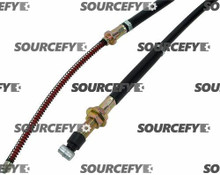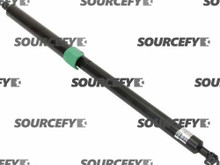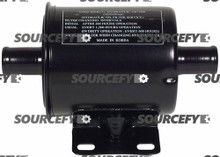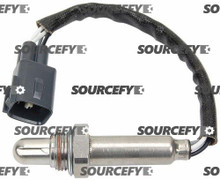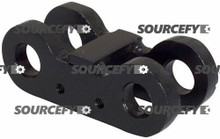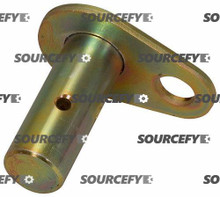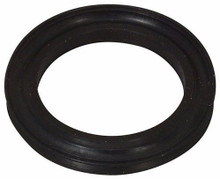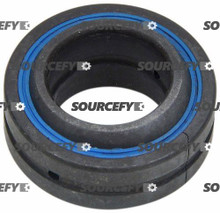- Home
- Forklift Parts
- Sensors
- Aftermarket Replacement SENSOR, OXYGEN 17410-26600-71 for Toyota
Forklift Parts SENSOR, OXYGEN 17410-26600-71
The 17410-26600-71 Oxygen Sensor for Toyota plays a crucial role in maintaining the efficiency and environmental performance of Toyota vehicles. This sensor is specifically designed to monitor the oxygen levels in the exhaust gases.
Doing so provides real-time data to the vehicle's engine management system. This feedback allows for adjustments to the air-fuel mixture, ensuring optimal combustion. An accurate air-fuel ratio is critical not only for maximizing performance but also for reducing harmful emissions.
Over time, a Toyota oxygen sensor may degrade due to contaminants and thermal stress, leading to less efficient fuel consumption and increased emissions. Regular checks and timely replacement of the oxygen sensor, such as the 17410-26600-71 model, are vital for maintaining the health and efficiency of Toyota engines, ultimately contributing to environmental sustainability.
Product Specifications
|
Part Type |
Oxygen Sensor |
|
Brand |
Aftermarket |
|
Manufacturer Part Number |
17410-26600-71 |
|
Compatible Equipment Make |
Toyota |
|
Model |
Toyota 17410-26600-71 |
|
Compatible Equipment Type |
Forklift |
|
Compatible Engine |
1FS, 1FZ, 4Y |
|
Pressure Tested |
Yes |
|
Length |
7 Inch |
|
Weight |
0.26 LB |
Features and Benefits:
-
Optimized Efficiency: Enhances fuel consumption by maintaining the ideal air-fuel ratio.
-
Reduced Emissions: Lowers harmful exhaust emissions, supporting environmental conservation.
-
Direct Fit: Specifically designed for seamless integration with Toyota models, ensuring easy installation.
-
Durability: Built to withstand high temperatures and harsh conditions, extending service life.
-
Precision: Offers highly accurate oxygen measurement for reliable engine performance.
-
Fuel Savings: Helps decrease fuel waste by ensuring efficient combustion.
-
Peak Performance: Assists in maintaining the engine's optimal performance level.
-
Cost-Effective: Reduces potential long-term maintenance costs by preserving engine health.
-
Quick Response: Rapidly detects oxygen levels, enabling swift adjustments to engine operations.
-
Regulatory Compliance: Aids in meeting stringent vehicle emission standards set by regulatory bodies.
Recommended Use/Applications
-
Enhances Hybrids: Optimal for Toyota hybrid engine efficiency.
-
Perfect Upgrade: Great replacement for aging or faulty sensors.
-
Essential for Diagnostics: Crucial tool for engine performance checks.
-
Optimizes SUVs: Boosts fuel efficiency in Toyota SUVs.
-
Improves Sedans: Enhances emission control in Toyota sedans.
-
Necessary for Repairs: Key part for routine engine maintenance.
-
Boosts Minivans: Helps maintain ideal fuel mixture in family vehicles.
-
Critical for Emissions Testing: Ensures passing of environmental compliance tests.
-
Supports Long Drives: Maintains engine health on extended journeys.
| Model | Engine | Required | Notes |
| TOYOTA 8FGU32 | 4Y | 1 | |
| TOYOTA 8FG35U | 1FS | 1 | |
| TOYOTA 8FG40U | 1FS | 1 | |
| TOYOTA 8FG45U | 1FS | 1 | |
| TOYOTA 8FG50U | 1FS | 1 | |
| TOYOTA 8FG60U | 1FS | 1 | |
| TOYOTA 8FG70U | 1FS | 1 | |
| TOYOTA 8FG80U | 1FS | 1 | |
| TOYOTA 8FGC35U | 1FS | 1 | |
| TOYOTA 8FGC45U | 1FS | 1 | |
| TOYOTA 8FGC55U | 1FS | 1 | |
| TOYOTA 8FGC60U | 1FS | 1 | |
| TOYOTA 8FGC70U | 1FS | 1 | |
| TOYOTA 8FGCSU20 | 4Y | 1 | |
| TOYOTA 8FGCU15 | 4Y | 1 | |
| TOYOTA 8FGCU18 | 4Y | 1 | |
| TOYOTA 8FGCU20 | 4Y | 1 | |
| TOYOTA 8FGCU25 | 4Y | 1 | |
| TOYOTA 8FGCU30 | 4Y | 1 | |
| TOYOTA 8FGCU32 | 4Y | 1 | |
| TOYOTA 8FGU15 | 4Y | 1 | |
| TOYOTA 8FGU18 | 4Y | 1 | |
| TOYOTA 8FGU20 | 4Y | 1 | |
| TOYOTA 8FGU25 | 4Y | 1 | |
| TOYOTA 8FGU30 | 4Y | 1 |
Application: Forklift
| Model | Serial Prefix | Engine/Power Unit | Category | Make |
| 8FG35U | - | 1FS | SWITCHESSENSORS | TOYOTA |
| 8FG40U | - | 1FS | SWITCHESSENSORS | TOYOTA |
| 8FG45U | - | 1FS | SWITCHESSENSORS | TOYOTA |
| 8FG50U | - | 1FS | SWITCHESSENSORS | TOYOTA |
| 8FG60U | - | 1FS | SWITCHESSENSORS | TOYOTA |
| 8FG70U | - | 1FS | SWITCHESSENSORS | TOYOTA |
| 8FG80U | - | 1FS | SWITCHESSENSORS | TOYOTA |
| 8FGC35U | - | 1FS | SWITCHESSENSORS | TOYOTA |
| 8FGC45U | - | 1FS | SWITCHESSENSORS | TOYOTA |
| 8FGC55U | - | 1FS | SWITCHESSENSORS | TOYOTA |
| 8FGC60U | - | 1FS | SWITCHESSENSORS | TOYOTA |
| 8FGC70U | - | 1FS | SWITCHESSENSORS | TOYOTA |
| 8FGCSU20 | - | 4Y | SWITCHESSENSORS | TOYOTA |
| 8FGCU15 | - | 4Y | SWITCHESSENSORS | TOYOTA |
| 8FGCU18 | - | 4Y | SWITCHESSENSORS | TOYOTA |
| 8FGU15 | - | 4Y | SWITCHESSENSORS | TOYOTA |
| 8FGU18 | - | 4Y | SWITCHESSENSORS | TOYOTA |
Frequently Asked Questions
What are the signs that I need to replace my oxygen sensor?
If you notice a decrease in fuel efficiency, erratic engine behavior, or failed emissions tests, it might indicate that the oxygen sensor needs replacing. These symptoms suggest the sensor no longer provides accurate data to manage the fuel-air mixture optimally.
How often should the oxygen sensor in a Toyota be replaced?
An oxygen sensor should typically be evaluated for replacement approximately every 60,000 to 90,000 miles. However, check your vehicle's owner's manual for specific recommendations related to your model.
Can I install an oxygen sensor on my Toyota myself?
Installing this part is doable for those with basic mechanical skills but requires specific tools like an O2 sensor socket. For precise installation, refer to a repair manual or consider professional assistance to ensure proper handling.
What benefits will a new Toyota oxygen sensor provide for my vehicle?
A new oxygen sensor can restore optimal fuel economy, enhance engine performance, and help achieve lower emissions. This contributes to improved overall efficiency and compliance with emission standards.
Is there a difference between upstream and downstream oxygen sensors?
Yes, upstream sensors are located before the catalytic converter and primarily adjust the air-fuel mixture, while downstream sensors monitor the efficiency of the catalytic converter. Both types are critical for the vehicle's emission system and should be specifically chosen based on the position required.
How do I choose the correct oxygen sensor for my Toyota?
Ensure compatibility by checking the part number, such as '17410-26600-71,' and confirm whether the sensor is meant for upstream or downstream placement. Always opt for a sensor that matches your vehicle model's specific requirements and layout.
Questions and Answers
Product Reviews
Customers Who Bought This Item Also Bought
-
$33.96 STEERING LINK 48512-FL100 for Nissan SKU: 48512-FL100
-
$15.36 PIN, TIE ROD 48513-FJ10B for Nissan SKU: 48513-FJ10B
-
$4.00 SEAL, DUST 48525-FJ100 for NISSAN SKU: 48525-FJ100
-
$15.84 BEARING, SPHERICAL 48544-51K02 for Nissan SKU: 48544-51K02
 Loading... Please wait...
Loading... Please wait...










